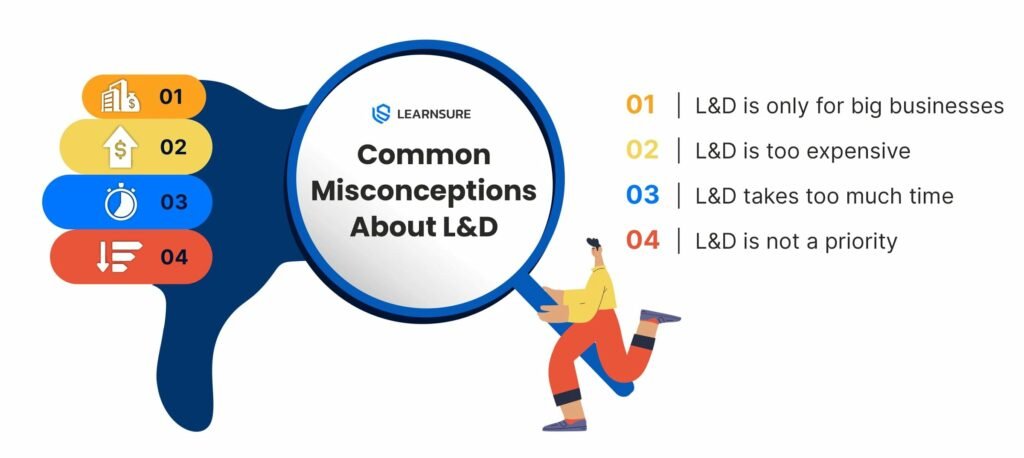Why should small & medium businesses never neglect learning and development?
Most businesses, especially small and medium-sized businesses, tend to neglect learning and development (L&D) initiatives. They either don’t see the need for it or they simply don’t have the budget for it. But what they fail to realize is that L&D is essential for businesses of all sizes.
Here are some common misconceptions about L&D:

1. L&D is only for big businesses.
The most common misconception about L&D is that it’s only for big businesses. This couldn’t be further from the truth. L&D is just as important for small and medium-sized businesses (SMBs). In fact, SMBs have a greater need for L&D because they often don’t have the same resources as larger businesses. For instance, replacing an employee can be very costly for small businesses. Not to mention, the time and money that it takes to train a new employee.
2. L&D is too expensive.
Another common misconception about L&D is that it’s too expensive. While it’s true that some L&D initiatives can be costly, there are many cost-effective ways to provide training and development for employees. You don’t have to break the bank to invest in L&D. There are several free or low-cost resources available, such as online courses, webinars, and books. Apart from this, you may generate your training materials using in-house senior professionals.
3. L&D takes too much time.
Many business owners believe that L&D takes too much time away from running their business. But this doesn’t have to be the case. There are many ways to incorporate L&D into your busy schedule. For instance, you can create an L&D plan that includes scheduled breaks for training throughout the day. Alternatively, you can offer employees the opportunity to participate in L&D activities during their free time.
4. L&D is not a priority.
The final misconception about L&D is that it’s not a priority. This couldn’t be further from the truth. L&D should be a top priority for all businesses. After all, your employees are your most valuable asset. By investing in their development, you’re investing in the future of your business.
Benefits of Learning and Development for SMBs.
L&D is essential for businesses of all sizes because it helps employees stay up-to-date with the latest skills and knowledge, which can make them more productive and efficient. Additionally, L&D can help reduce turnover rates and save businesses money in the long run. Here are some other benefits of L&D for SMBs:

1. Improved Employee Performance
One of the most important benefits of L&D is that it can improve employee performance. By providing employees with the training and development they need, you can help them become more efficient and productive. Additionally, L&D can help employees become better problem-solvers and critical thinkers.
2. Increased Employee Engagement
L&D can also lead to increased employee engagement. When employees are allowed to participate in L&D activities, they often feel more valued and appreciated by their employers. Additionally, L&D can help employees feel more connected to their work and their company.
3. Attracts and retains top talent
Another benefit of L&D is that it can help businesses attract and retain top talent. Employees want to work for companies that invest in their development. Furthermore, L&D can help businesses retain their best employees by providing them with the skills and knowledge they need to stay ahead of the competition.
4. Improved bottom-line results
Finally, L&D can improve bottom-line results. Businesses that invest in L&D often see a decrease in turnover rates and an increase in productivity. Additionally, L&D can help businesses generate new ideas and innovative solutions to common problems.
5. It future-proofs your business
As the world continues to change, it’s important for businesses to future-proof themselves. L&D can help businesses do this by providing employees with the skills and knowledge they need to stay ahead of the curve. Additionally, L&D can help businesses keep up with changes in technology, trends, and regulations.
Smart Approach to L&D
Unlike big corporations, SMBs don’t have the luxury of a large budget for L&D. However, this doesn’t mean that L&D isn’t important for SMBs. On the contrary, L&D is essential for all businesses, regardless of size. This means that they need to be smart in their approach to L&D to ensure that the time and money they do invest is well spent.
Here are some tips for taking a smart approach to L&D:
1. The best does not have to be the most expensive
Just because a program is expensive doesn’t mean it’s the best option for your business. There are many high-quality, affordable L&D programs available. You could use social media, free internet resources, and even in-house experts to provide employees with the training they need. Typically, the most important thing is to find a program that meets the specific needs of your business.
2. Act big at a small level
Although you may be limited by your budget, that doesn’t mean you can’t provide employees with high-quality L&D opportunities. There are many ways to get creative with L&D and make it work for your business. For example, you could create an in-house expert network, host webinars, or create a library of e-learning resources.
3. Start with the basics
When it comes to L&D, it’s important to start with the basics. Before you invest in costly programs, make sure that your employees have the basic skills and knowledge they need to do their jobs effectively. Once you’ve covered the basics, you can then start to focus on more specialized training.
4. Train your leaders
One of the best investments you can make in Learning in Development is to train your leaders. By providing leaders with the skills and knowledge they need to effectively manage and motivate employees, you can make a big impact on your business.
5. Train in the flow of work
Another smart approach to L&D is to integrate training into the flow of work. This means that employees receive training as they need it, rather than in a separate training program. For example, you could provide employees with on-the-job training, just-in-time training, or microlearning.
Conclusion
L&D is essential for all businesses, regardless of size. By neglecting Learning and development, SMBs stand to miss out on many benefits, including improved employee performance, increased productivity, and attraction of top talent. As mentioned in the article, the trick is to take a smart approach to L&D and make the most of your resources.
